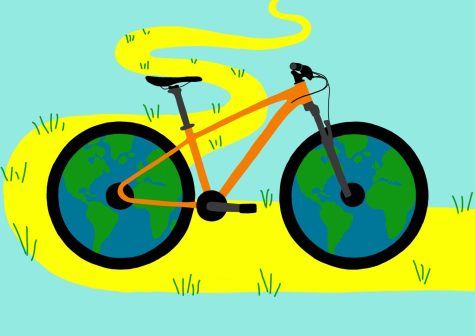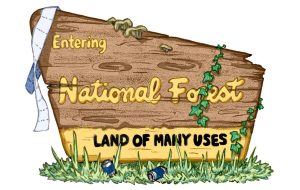Biking for a better future
November 3, 2022
On Oct. 15, I had the pleasure of joining a bike ride hosted by the Sustainable Living Center (SLC) with the purpose of visiting community members working on sustainable projects. One of the most important takeaways from this experience was that the things that are good for the environment are often good for us.
We are intricately connected to the environment, whether it be through our actions, where we make our homes, where we work, where we run or where we go when we need a quiet moment to ourselves.
As a Whitman student, I often find myself out of touch with the rest of Walla Walla. The SLC bike ride provided me with an opportunity to integrate myself with the community, get to know the place in which I’m living and connect with other people who call Walla Walla home.
Our travels spanned the course of five hours and 13 miles, taking us from The Walls Vineyards, the Water-Wise Garden and Ankeny Field to the Builders ReSupply, Walla Walla Community College’s Water & Environmental Center and Mill Creek.
All in all, it was quite the day. One of the highlights of the tour was the energy and engagement from each participant.
Dani Dolphin, the Education and Outreach Specialist for the SLC, was “blown away by the enthusiasm everyone brought on Saturday.”
Everyone was there for a reason, and it struck a powerful chord to see so many engaged community members.
At first, I was nervous (as we all tend to be when we step outside of our comfort zone). As the day continued, with the sun rising high and warm in the sky and the wind dancing around my pedaling feet, I settled into the event and the group. We got to know each other by sharing stories and experiences.
Our first stop took us to The Walls Vineyards. As we turned a corner and entered the back of the winery, we were met by Chris Lueck to discuss his project called “Ground2Ground Glass.”
Ground2Ground Glass aims to address one of the major sustainability issues in Walla Walla: the lack of recycling. This is an issue many residents want change.
“Almost on a yearly basis, residents of Walla Walla have asked why they can’t recycle glass,” Lueck said.
Lueck decided to get involved in addressing the recycling deficiency, drawing inspiration from countries that have implemented similar programs. Ground2Ground Glass grinds wine bottles into a fine sand, which can then be used to create sandbags. These sandbags can be used to fill potholes or landscape.
Lueck hopes that the United States can institutionalize this process, but there is still work to do. Currently, Ground2Ground Glass can only process wine bottles. This is an important step, considering the size of the local wine industry, but it is not comprehensive. There is still room for activism and innovation when it comes to recycling in Walla Walla.
We left the winery, hands shimmering with glass sand residue, and then swung by my familiar stomping grounds. While wandering the Water-Wise Garden’s winding paths, discussion broke out among participants about the future of the project. Who was maintaining the garden? Had anyone ever thought about bringing in community members? How about creating a place for Whitman students and Walla Walla residents to come together and give back to the land and community together?
There are endless possibilities ahead for how we want to move through our homes and interact with the land, and striking up conversations with new people is a way to do this.
20 minutes and three flat tires later, we made it to the SLC’s Builders ReSupply.
At this point, we were several hours into the ride, and we hastened to a table filled with snacks and refreshments once we set our bikes down. Laughter broke out among participants, volunteers patched tires and we enjoyed the October sunshine.
Erendira Cruz, the Executive Director of the SLC, showed us around the Builders ReSupply. Like an old bookstore, it’s a place you can get lost in, exploring every inch of the place on the hunt for the perfect item. The Builders ReSupply houses used building materials so residents can purchase items secondhand. This reduces waste and offers an affordable option. For any students moving into off-campus houses next year, the Builders ReSupply is your best friend (I know I’ll be making a trip out there next fall).
It took a moment to readjust to the outside world after immersing myself in the Builders ReSupply. I grabbed an extra poppy seed muffin from the snack table, thanked the folks who had greeted us and showed us around and then began biking once more. The route took us gradually downhill to our next location and we coasted, keeping an eye out for any goat heads laying in wait. After an exhilarating highway crossing, we regrouped at Walla Walla Community College (WWCC) to hear our next speaker, Whitman alumnus Andrew Trogstad-Isaacson ’11.
Trogstad-Isaacson is the Assistant Director of the William A. Grant Water & Environmental Center at WWCC. Underneath orange and red autumn leaves, he told us about the wind turbine just outside the parking lot (the planning and construction of which involved students at every step), educational programs that make use of the center and the school’s solar arrays, which glittered in the sunlight. Multiple departments use the center: the water department provides the space and tools, the agricultural department practices irrigation and grows crops and the culinary department cooks with those crops. Connecting to the local environment allows us to derive many uses from one small plot of land.
Diving into the nuances of water systems grows increasingly important in a drought-heavy climate. This issue is painfully clear after this October, which saw high temperatures and little rainfall.

“The single biggest issue of the next 50+ years throughout the American West will be increasing our efficiency of water usage in all phases of our lives,” Trogstad-Isaacson said.
Conversations are happening around campus about Whitman’s water usage, and more voices can only help.
After parting ways with WWCC, we wrapped up the tour at the Mill Creek Project office.
Mill Creek Project Operations Manager Austin Kuhlman spoke about balancing different needs. His work revolves around flood management, recreation and ecology. During his talk, Kuhlman discussed current projects: new fish ladders and the construction of low flow channels to aid fish. Being up-to-date about local projects is critical in navigating the state of sustainability in one’s community.
Emerging from the final stop and reuniting with my bike, I felt the richness of the past several hours settle over my body. It can be exhausting to read about climate change and environmental devastation, so taking the time to appreciate current sustainable action is a breath of fresh air. Plus, like Fritts said, biking is good for us.
I began biking at Whitman as a means of moving my body, but it has given me a strong appreciation for this place. I find myself noticing the changing colors of the honey locusts, saying hello to herons and observing the snow’s slow creep down the Blues.
After the tour, I had the opportunity to follow up with some of the presenters. I began by asking what sustainability means to them.
“Sustainability means that we can meet people [and together] do things better for a healthier and more viable future on our planet,” Cruz said.
“Sustainability is working together to secure our resources (environmental, social, economic), create equitable access to those resources and support our communities for the future,” Dolphin said.
Trogstad-Isaacson defines sustainability as a “societal goal to co-exist with the natural world in a harmonious way for as long as possible without causing unnecessary harm.”
“Personally, sustainability means balance,” Kuhlman said. While working in the resource management field, he looks for ways to balance the desires of disparate groups with the protection of ecosystems and recreation opportunities.
There are many ways to define sustainability and even more ways to approach it. Dolphin and Trogstad-Isaacson urged students to reach out to local organizations and nonprofits to discover volunteering opportunities. Often, organizations don’t advertise openings, but they would be excited to work with students.
“Don’t just get a degree, get your hands dirty,” Kuhlman said. Our education is important, but it’s also important not to lose sight of what other experiences are out there. This doesn’t mean we should disregard action that needs to happen on campus — generating change at Whitman is vital to creating a more sustainable Walla Walla. However, we shouldn’t neglect projects going on in the community.
One important way to get involved in the community? Vote.
“I believe participating in our democracy is the greatest power we have,” Fritts said. Voting is a way to synthesize much of the knowledge we gain from reaching out to the community, and we cannot underestimate its power, especially in local elections. There is so much going on in our local communities, and it is critical that we connect ourselves with these events, whether it be through reaching out to nonprofits, volunteering, voting, starting conversations or simply getting outside on a bike.





